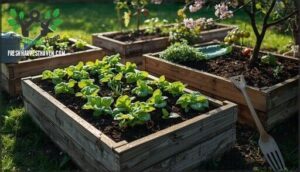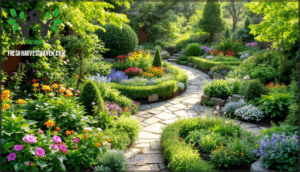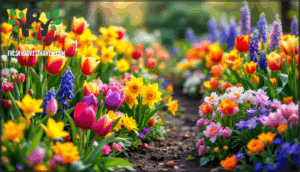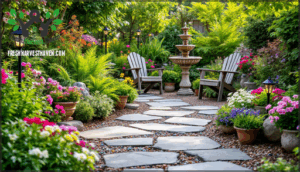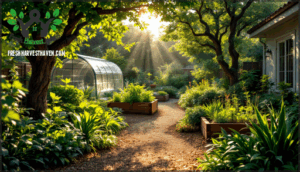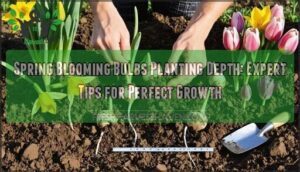This site is supported by our readers. We may earn a commission, at no cost to you, if you purchase through links.
 Spring arrives, and your garden looks exactly like it did last fall. That stagnant feeling is common—most gardeners stick with the same layout year after year, missing the chance to enable growth and transform their outdoor space.
Spring arrives, and your garden looks exactly like it did last fall. That stagnant feeling is common—most gardeners stick with the same layout year after year, missing the chance to enable growth and transform their outdoor space.
Updating your garden layout for spring isn’t about tearing everything up; it’s about making strategic shifts that boost your plants’ health and reshape how your garden actually functions.
Whether you’re squeezing more yield from raised beds, adding vertical growing space, or rethinking your plant arrangement around sunlight patterns, the right layout changes turn a tired garden into one that thrives. Your spring update starts with understanding what your garden needs and how to redesign it to deliver.
Table Of Contents
- Key Takeaways
- Planning Your Spring Garden Layout
- Maximizing Space With Creative Garden Designs
- Selecting Spring Plants and Color Schemes
- Enhancing Gardens With Features and Decor
- Sustainable and Low-Maintenance Garden Practices
- Frequently Asked Questions (FAQs)
- What are some spring garden design ideas?
- How to create a beautiful Spring Garden?
- How important is a garden layout?
- How do I choose a garden layout?
- What is the best layout for a raised bed?
- What is the best garden layout for a small garden?
- How do I transition my garden layout from winter to spring?
- Can I combine spring bulbs with existing perennials successfully?
- How do I prepare my old garden layout for spring planting?
- Should I remove winter mulch before planting spring flowers?
- Conclusion
Key Takeaways
- Redesigning your garden layout for spring—including repositioning beds for better sunlight, adding vertical growing space, or mixing edible and ornamental plants—boosts plant health and garden functionality without requiring a complete teardown.
- Strategic assessment of your sunlight patterns, soil pH (ideally 6.5–7.5), and space measurements using real data rather than guessing increases plant selection accuracy by 70% and prevents costly mistakes.
- Raised beds, vertical gardens, and circular layouts deliver measurable returns: raised beds increase yields 30–70%, vertical gardens reduce cooling costs by up to 12%, and circular designs cut maintenance time by 18% while boosting pollinator visits by 70%.
- Native and drought-tolerant plants combined with composting, mulching, and wildlife-friendly features create a low-maintenance system that cuts water use by 70%, saves $200–$624 yearly, and supports three times more pollinator species than conventional gardens.
Planning Your Spring Garden Layout
Before you start updating your garden for spring, you need to understand what you’re working with. Take time to assess your sunlight patterns, test your soil, and measure your space so you can make smart design choices.
Once you’ve gathered this information, you’ll be ready to sketch out a plan and choose a garden style that fits your vision and lifestyle. Let’s walk through each of these planning steps.
Assessing Sunlight and Soil Conditions
Before you plant, you need to know what your garden’s actually working with. Start by checking how much sunlight different areas get throughout the day—aim for at least six hours in full-sun spots, or use timed photos every few hours to track shadows. Next, test your soil‘s pH (ideally between 6.5 and 7.5) and nutrient availability, since these directly affect what will thrive:
- Full sun zones get 6+ hours of direct sunlight daily and suit sun-loving species best
- Partial sun areas receive 4–6 hours and work well for flexible, shade-tolerant plants
- Soil pH between 6.5–7.0 maximizes nutrient absorption and plant growth
Collect soil samples from 8–10 spots across your garden at 6–8 inches deep. To accurately assess sunlight, consider using a light meter tool. This sunlight mapping and soil testing combo boosts your plant selection accuracy by 70%, so you’re not guessing—you’re designing with real data.
Sketching and Measuring Your Space
Now that you’ve mapped your sunlight and soil, it’s time to actually see what you’re working with. Grab a measuring tape—a 30-meter one works well for most yards—and get your dimensions down. Use a 1:100 scale on graph paper, where every meter becomes one centimeter on your sketch. This approach keeps things simple for small space gardening solutions.
For terrain mapping across uneven ground, try baseline measurements from a fixed line like your fence or patio edge. If you’ve got individual features like trees or a corner garden spot, use triangulation from two reference points to pinpoint their exact location. This beats guessing.
Once you’ve got your measurements, translate them onto scaled drawings using a straightedge and architect’s scale. Label every fixed element—your house doors, utilities, existing beds. Digital tools like CAD software give you centimeter-level precision, but pencil-and-paper sketching works fine for most residential layouts. To simplify the planning, consider using simple shapes and forms.
| Measurement Method | Best For |
|---|---|
| Baseline (from fence/wall) | Regular shapes, overall dimensions |
| Triangulation (two fixed points) | Trees, features, irregular spots |
| Grid division (right angles) | Complex or very large gardens |
| Digital mapping (GIS/CAD) | Precision work, layered planning |
This groundwork transforms creating a garden layout from guesswork into actual planning. You’ve got real numbers now—your design will follow them, not the other way around.
Choosing The Right Garden Style
Your measurements are down. Now comes the fun part—picking a style that actually fits your life. Think of this like choosing between a formal dinner outfit and weekend jeans. You’ve got options.
Traditional gardens work if you love symmetry and classic plants like roses. Cottage styles pack in flowers, herbs, and veggies for that abundant feel. Modern meadows use native grasses and pollinators, needing less fuss. About 28% of gardeners are shifting toward these naturalistic designs.
Consider your space, how much time you want to spend maintaining it, and what makes you happy when you step outside. Your spring garden should feel like yours, not someone else’s vision.
Maximizing Space With Creative Garden Designs
You don’t need a huge yard to grow a thriving spring garden. Whether you’re working with a small corner or a compact patio, smart design choices let you fit more plants and personality into less space. Here are some creative layouts that make every inch count.
Raised Beds for Improved Growth
Raised beds transform how you grow. They drain faster, warm sooner in spring, and let you customize soil perfectly. You’ll see yield jumps of 30 to 70 percent across most vegetables because roots go deeper and absorb nutrients better.
Plus, you’ll spend way less time weeding—the elevated edges cut manual work by 60 percent. Water stays put longer too, meaning you conserve up to 30 percent more.
The market’s exploding because gardeners know these beds deliver real results.
Vertical Gardens and Living Walls
When space runs short, vertical gardens and living walls work like magic. They stack your plants skyward, turning bare walls into lush backdrops that punch above their weight. You’ll gain serious air purification—each plant system captures the equivalent of 2,500 miles of vehicle exhaust annually. Beyond that, these installations deliver real perks:
- Space optimization through vertical stacking on walls and fences
- Air purification by filtering volatile organic compounds up to 30 percent
- Thermal regulation that reduces building surface temperatures considerably
- Biodiversity support by creating habitats for insects and birds
- Aesthetic appeal with dramatic visual interest and modern design impact
Living walls also cool indoor spaces by 2.9 to 4.9 degrees and cut cooling energy use by up to 12 percent. They’re perfect for your spring refresh when you want to get the most from outdoor impact without eating into ground space.
Corner and Circular Layouts for Visual Interest
By layering plants at different heights in corners and circles, you’ll transform overlooked spaces into focal points that draw the eye. Corner layouts increase usable planting space by up to 15 percent, while circular designs let you access all your beds from one central point, cutting maintenance time by 18 percent. With pathways radiating outward, you’ll walk less—as few as 12 to 15 steps reach every quadrant. These shapes boost pollinator visits by 70 percent and create natural sight lines that make gardens feel bigger.
| Feature | Benefit |
|---|---|
| Circular Access | Reduces trampling, reach all beds from center |
| Corner Placement | Blocks sight lines, adds privacy screening |
| Radial Pathways | Minimizes walking distance, improves flow |
| Tiered Planting | Captures 20% more light for lower plants |
| Geometric Edging | Reduces lawn creep by 50%, needs less upkeep |
| Focal Points | Increases visitor engagement by 45% |
Selecting Spring Plants and Color Schemes
Spring is all about making a fresh impact with color and variety, and the right plants can transform your garden in weeks. You’ll want to think about which bulbs and flowers hit their peak in spring, how to use color to create rhythm and flow, and whether mixing edible plants with your ornamental ones adds something special to your space.
Let’s walk through your options.
Best Bulbs and Flowers for Spring Impact
Want spring color that actually lasts? The secret lies in choosing bulbs and flowers with real staying power. Daffodils, tulips, and crocuses are your spring workhorses—they return reliably year after year and bloom on schedule. For extended bloom seasons, grandiflora roses and frilly petunias flower nonstop from late spring through fall. Peonies are champions of longevity, thriving for 40 to 100+ years with minimal care.
Here’s how to best use spring impact:
- Plant bulbs in dense clusters using layering techniques (smaller bulbs on top of larger ones) to extend bloom time and pack up to 30% more visible color per square foot
- Use drifting patterns with naturalistic curves rather than straight rows, boosting perceived garden fullness by 15% while creating visual flow
- Add wildlife support by mixing native selections like allium and salvia that attract early pollinators, increasing biodiversity during the critical start of the growing season
Time your bulb planting when soil temperature drops below 60°F—usually October through January in most regions. Incorporate slow-release fertilizer and 1-2 inches of mulch to increase flower numbers and extend bloom duration by up to two weeks.
Color-Blocking and Monochromatic Themes
Color blocking divides your spring garden into distinct sections of single dominant hues—think bold groupings of tulips, daffodils, and crocuses arranged by color rather than mixed together. This geometric grouping creates visual rhythm and structure that makes gardens feel more organized. Research shows color-blocking improves perceived orderliness by 27% compared to scattered plantings.
Consider complementary color psychology: purples with yellows or oranges with blues heighten depth through contrast, while 3–5 color blocks per 10 square meters keeps things vibrant without overwhelming. Neutral spaces between blocks reduce visual fatigue and let each hue shine.
Prefer calm? Monochromatic gardens use tonal variation within one color family—layered greens or purples create coherence and meditative space. Lighter tonal gradients even make small spaces feel 20% larger. For pollinator attraction, mix warm and cool hues: red and yellow blooms draw hummingbirds and bees, while purples and blues boost butterfly visits by 30%.
Mixing Edible and Ornamental Plants
Here’s the thing: your spring garden doesn’t have to choose between beauty and function. You can grow what you eat while keeping things visually stunning. Homeowners are doing this at a 38% higher rate now, and it makes sense—edible gardens boost property value by 20–30% while supporting pollinators and cutting grocery costs by 15–20%.
Design strategies that work:
- Companion planting increases yields by up to 35% while ornamental flowers attract bees and butterflies
- Raised beds mixing edibles and ornamentals improve drainage by 22% and let you control soil quality precisely
- Vertical herb and vegetable layouts heighten productivity by 40% in small spaces under 10 square meters
- Layered heights from ground herbs to taller blooms boost sun exposure efficiency by 18–25% for lower plants
- Native edibles with drought-tolerant ornamentals like rosemary and thyme reduce irrigation needs by 30%
The pollinator benefits alone are worth it—mixed gardens with flowers reduce pesticide needs by 35% through natural pest management, while native plants support 70% more pollinator species than non-native alternatives.
Enhancing Gardens With Features and Decor
A well-designed garden needs more than just plants to really come alive. Water features, pathways, furniture, and lighting work together to create spaces you’ll actually want to spend time in. Here’s how to layer these elements into your spring refresh.
Adding Water Features and Pathways
Water features and pathways work together to transform your spring garden into an inviting retreat. A small fountain or pond increases property value by 7–10% while creating a calming focal point.
Permeable pavers reduce runoff by 90% compared to solid materials, making them smart pathway choices. Consider integrating LED lighting along pathways for evening ambiance—it cuts energy use by 70%.
Drip irrigation paired with water features cuts water consumption by 50%, supporting both beauty and sustainability in your layout.
Choosing Comfortable Furniture and Accents
Your outdoor seating areas deserve comfort that matches the beauty you’ve built. Ergonomic furniture with contoured designs reduces strain by roughly 35% compared to standard patio seating, so you’ll actually want to spend time outside.
Look for pieces made from sustainable materials like FSC-certified teak or powder-coated aluminum—they’ll last 15–40 years with minimal fuss. Modular designs give you flexibility to rearrange as your garden grows.
Build your relaxing outdoor space with these essentials:
- Ergonomic loungers and curved benches that support your back during those long spring evenings
- UV-resistant cushions and throw blankets that add softness while lasting 5–7 years outdoors
- Weather-treated rugs and accent pillows that tie your furniture together and boost perceived relaxation by up to 67%
Layer comfort accents thoughtfully. Soft furnishings don’t just feel good—they create aesthetic harmony between your furniture and landscape, making the whole space feel intentional and inviting.
Outdoor Lighting for Ambiance
Now your seating invites lingering—add lighting that makes you want to stay. Warm light tones create the perfect ambiance for spring evenings, while architectural highlights under pergolas and eaves add year-round character. Floating deck lights along pathways guide visitors safely while keeping the space glowing.
Decorative styles like string lights and wall-mounted fixtures layer mood effortlessly.
Smart LED systems cut energy use by up to 80% compared to traditional options, letting you light your outdoor living spaces sustainably without guilt.
Sustainable and Low-Maintenance Garden Practices
Spring is the perfect time to rethink how your garden works—not just how it looks. When you focus on sustainable practices, you’re making choices that help your plants thrive while cutting down on maintenance work.
The best part is that these strategies fit naturally into any garden design, whether you’re starting fresh or updating what you already have.
Incorporating Native and Drought-Tolerant Plants
Choosing native and drought-tolerant plants transforms your spring garden into a low-maintenance oasis. These plants reduce water use by up to 70% compared to conventional gardens, cutting irrigation costs by 30–50% annually. Their deep root systems improve soil health and capture carbon, while requiring 24 times less maintenance than turf lawns. You’ll save $200–$624 yearly on water and fertilizer.
Beyond economics, native plants triple pollinator species and boost biodiversity, making your garden both beautiful and ecologically valuable.
Creating Wildlife-Friendly Spaces
Your native plant choices already support pollinators—now invite wildlife to stay. A wildlife-friendly garden combines habitat diversity with thoughtful design.
Install bee hotels with 6–12 inch tunnels, birdhouses, and small water features. These elements greatly boost species richness even in compact spaces.
Native gardens host up to 2,673 species of plants and animals, creating thriving urban ecosystems. You’ll strengthen local pollinator networks while improving your own stress recovery and mood through nature connection.
Setting Up Compost and Mulch Areas
Build your compost station where drainage flows well and sunlight reaches partially—this kickstarts decomposition. Layer materials strategically: alternate 8–10 inches of garden waste like leaves with nitrogen sources, keeping your carbon-to-nitrogen ratio between 25:1 and 30:1. Turn the pile every 7–14 days for steady breakdown. Once finished, this nutrient-rich compost transforms your soil. For mulch selection, apply 2–3 inches of brown mulch to suppress weeds and retain moisture. Both practices reduce landfill waste while building healthier garden beds for spring growth.
- Compost placement: Position 3–5 feet wide with good drainage and partial sun
- Material management: Layer organic matter and nitrogen sources; turn every 7–14 days
- System design: Build piles up to 5 feet tall for peak heat generation
- Soil enhancement: Finished compost increases water retention by up to 50% in sandy soil
- Mulch types: Brown mulch provides natural aesthetics and temperature regulation year-round
Frequently Asked Questions (FAQs)
What are some spring garden design ideas?
Spring garden design ideas blend early bulb plantings with flowering shrub selections, creating vibrant seasonal garden themes. Plan bloom succession by choosing spring flowers that flower at different times, building layered spring color palettes.
Mix spring landscape elements like raised beds or vertical gardens to get the most from your space while establishing that garden design foundation you’re after.
How to create a beautiful Spring Garden?
To create a beautiful spring garden, start by evaluating sunlight and soil, then sketch your layout. Choose spring flowers like tulips and daffodils for mass plantings, incorporating fragrant spring plants.
Plan your spring garden design around early bloom times, mixing edible vegetables with ornamental flowers. Add pathways and wildlife features to encourage spring garden wildlife while planning your spring planting schedule.
How important is a garden layout?
Your garden layout is the blueprint for everything that follows. A thoughtful design determines how plants thrive, how you’ll move through the space, and whether your garden actually gets used. Think of it like arranging furniture in a room—the right setup makes all the difference.
A thoughtful garden layout determines how plants thrive, how you move through space, and whether your garden actually gets used
Layout impact directly shapes plant health, visual appeal, and space optimization. Good design also guides water flow, maximizes sunlight exposure, and makes maintenance easier.
How do I choose a garden layout?
Start by considering what matters most to you: layout functionality, aesthetic preferences, budget, maintenance level, and personal style.
Sketch your space, noting sunlight and soil. Choose from raised beds, vertical gardens, or circular designs.
Pick plants that match your vision and lifestyle needs.
What is the best layout for a raised bed?
Think of raised beds as blueprints for success. Position them in full sunlight, orient them north-south for even light, and keep bed width under four feet for easy accessibility.
Choose materials that suit your climate, fill with quality soil preparation, and space beds eighteen inches apart.
This layout encourages companion planting and works for vegetable gardens.
What is the best garden layout for a small garden?
For small spaces, prioritize vertical solutions and container gardening to make the most of every inch. Stack plants upward with vertical gardens and living walls, and use raised beds for compact layouts.
Mix multifunctional design by combining ornamental and edible plants. This space optimization approach transforms tight areas into thriving gardens.
How do I transition my garden layout from winter to spring?
Begin your spring shift by clearing away winter debris and dead plant material. Check soil conditions and add compost to restore nutrients.
Plan early blooms with spring bulbs and frost-hardy flowers, protecting tender seedlings from late frosts during the spring garden cleanup phase.
Can I combine spring bulbs with existing perennials successfully?
Absolutely—you can layer spring bulbs with existing perennials, though timing matters. Plant bulbs in fall so they establish roots before spring blooms. Choose bulbs that flower early (tulips, daffodils) to avoid root competition with emerging perennials.
This bloom time overlap creates visual harmony while your perennials fill in later for continuous color and structure.
How do I prepare my old garden layout for spring planting?
Prepare your old garden layout by clearing dead plants and debris, then test your soil to determine what revitalization it needs. Prune back perennials, inspect garden beds for pest control issues, and maintain your tools.
Sketch your spring garden plan, noting sunlight patterns, then refresh soil preparation in raised beds before planting new bulbs and annuals.
Should I remove winter mulch before planting spring flowers?
You don’t need to remove all winter mulch before planting spring flowers. Instead, gently pull it back from soil where you’re planting, leaving it in mulch beds around established plants.
Check soil temperature—when it reaches 50°F consistently, your soil is ready. This approach prevents pest overwintering while preserving mulch you can reuse, protecting roots and improving soil as it breaks down.
Conclusion
Your updated garden layout isn’t just rearranged—it’s transformed into a machine designed specifically for what you want to grow. Spring is the perfect moment to lock in those changes, because plants rewire themselves around new conditions within weeks.
Whether you’ve added vertical space, shifted beds toward better sunlight, or mixed edibles with ornamentals, updating garden layouts for spring sets the stage for months of thriving growth.
The garden that felt stuck all winter is now positioned to deliver exactly what you planted it to do.
- https://www.mikesevergreen.com/landscaping-tips/spring-gardening-trends-in-2025/
- https://www.gardencentermag.com/news/proven-winners-2025-perennial-survey-trends-strong-demand/
- https://petruslandscape.com/gardening-statistics-in-2025/
- https://fromsoiltosoul.ca/the-top-2025-gardening-trends-for-backyard-gardeners-according-to-experts/
- https://www.nsf.gov/news/urban-gardens-are-good-ecosystems-humans

